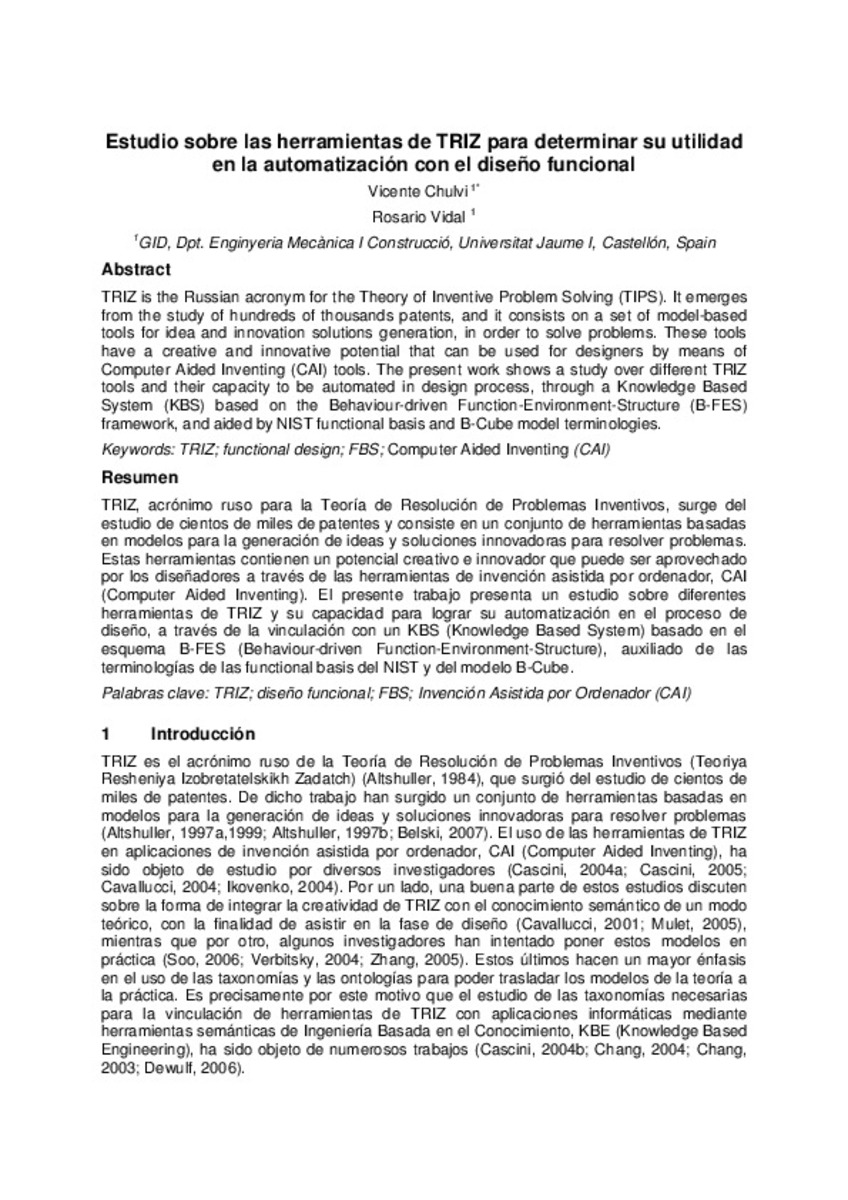Mostrar el registro sencillo del ítem
Estudio sobre las herramientas de TRIZ para determinar su utilidad en la automatización con el diseño funcional
| dc.contributor.author | Chulvi, Vicente | |
| dc.contributor.author | Vidal, Rosario | |
| dc.date.accessioned | 2014-02-07T10:07:22Z | |
| dc.date.available | 2014-02-07T10:07:22Z | |
| dc.date.issued | 2009 | |
| dc.identifier.citation | Chulvi, V.; Vidal, R. Estudio sobre las herramientas de TRIZ para determinar su utilidad en la automatización con el diseño funcional. En XIII Congreso de Ingenieria de Proyectos (AEIPRO), Badajoz 8-10 Julio 2009, p. 1777-1788 | ca_CA |
| dc.identifier.uri | http://hdl.handle.net/10234/82666 | |
| dc.description | Ponencia presentada en el XIII Congreso Internacional de Ingeniería de Proyectos celebrado en Badajoz , 8-10 de julio de 2009 | ca_CA |
| dc.description.abstract | TRIZ is the Russian acronym for the Theory of Inventive Problem Solving (TIPS). It emerges from the study of hundreds of thousands patents, and it consists on a set of model-based tools for idea and innovation solutions generation, in order to solve problems. These tools have a creative and innovative potential that can be used for designers by means of Computer Aided Inventing (CAI) tools. The present work shows a study over different TRIZ tools and their capacity to be automated in design process, through a Knowledge Based System (KBS) based on the Behaviour-driven Function-Environment-Structure (B-FES) framework, and aided by NIST functional basis and B-Cube model terminologies. | ca_CA |
| dc.description.abstract | TRIZ, acrónimo ruso para la Teoría de Resolución de Problemas Inventivos, surge del estudio de cientos de miles de patentes y consiste en un conjunto de herramientas basadas en modelos para la generación de ideas y soluciones innovadoras para resolver problemas. Estas herramientas contienen un potencial creativo e innovador que puede ser aprovechado por los diseñadores a través de las herramientas de invención asistida por ordenador, CAI (Computer Aided Inventing). El presente trabajo presenta un estudio sobre diferentes herramientas de TRIZ y su capacidad para lograr su automatización en el proceso de diseño, a través de la vinculación con un KBS (Knowledge Based System) basado en el esquema B-FES (Behaviour-driven Function-Environment-Structure), auxiliado de las terminologías de las functional basis del NIST y del modelo B-Cube. | ca_CA |
| dc.format.extent | 12 p. | ca_CA |
| dc.format.mimetype | application/pdf | ca_CA |
| dc.language.iso | spa | ca_CA |
| dc.publisher | Asociación Española de Dirección e Ingeniería de Proyectos (AEIPRO) | ca_CA |
| dc.rights.uri | http://rightsstatements.org/vocab/CNE/1.0/ | * |
| dc.subject | TRIZ | ca_CA |
| dc.subject | functional design | ca_CA |
| dc.subject | FBS | ca_CA |
| dc.subject | Computer Aided Inventing (CAI) | ca_CA |
| dc.subject | diseño funcional | ca_CA |
| dc.subject | Invención Asistida por Ordenador (CAI) | ca_CA |
| dc.title | Estudio sobre las herramientas de TRIZ para determinar su utilidad en la automatización con el diseño funcional | ca_CA |
| dc.type | info:eu-repo/semantics/conferenceObject | ca_CA |
| dc.rights.accessRights | info:eu-repo/semantics/openAccess | ca_CA |
| dc.relation.publisherVersion | http://aeipro.com/index.php/es/repository/congresos/congresos_badajoz2009/congresos_badajoz2009_08/ESTUDIO-SOBRE-HERRAMIENTAS-DE-TRIZ-PARA-DETERMINAR-SU-UTILIDAD-EN-LA-AUTOMATIZACION-CON-EL-DISE%C3%91O-FUNCIONAL/ | ca_CA |







